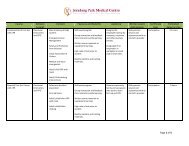Diagnostic Imaging - Jerudong Park Medical Centre
Diagnostic Imaging - Jerudong Park Medical Centre
Diagnostic Imaging - Jerudong Park Medical Centre
Create successful ePaper yourself
Turn your PDF publications into a flip-book with our unique Google optimized e-Paper software.
What is Ultrasound ?Ultrasound is an easy and non-invasive way tosee the internal structures of the body by sendinghigh frequency sound waves through skin. In anabdominal examination, ultrasound produces imagesto be seen on most of the major organs including theliver, gallbladder, pancreas, spleen kidneys and largeblood vessels.The principle behind ultrasound or “sonar” is thesame as what was used during World War II to locateenemy submarines beneath the sea. The machine,a transducer, sends a brief pulse of sound (abouta millionth of a second long) into the body. Thissound travels into the abdomen and when it reachesa structure, the travelling pulse will send back a littleecho. With the use of high-speed computer, an imageof the organ being examined is seen on the TV monitorof the machine. Sounds produced by the transducerare very high pitched and are unable to be heard byhumans.How long will it take ?The length of time for all examinations willvary depending on the specific reasons for yourexamination. For some studies, such as examinationof the gallbladder for stones, may require only 15minutes. For a complete study of the abdominal organsor pelvis, 45 minutes or more may be required.Will it hurt ?There is little or no pain involved in an ultrasoundexamination of your abdomen, although, there maybe some discomfort from maintaining a full bladder.A gel-like material is applied to your abdomen andthe instrument is then placed on the skin surface toprovide better contact between the transducer and theskin. This gel may feel slightly cold and even thoughit wipes off easily, it is a good idea to wear clothingthat is easily washable.What are the limitations of the examination ?As bone attenuates sound waves, ultrasound cannot beused to examine the bones surrounding the abdomen,such as your ribs. Also, as sound is weakened as itpasses through layers of tissue, results from patientswho are obese are not of the same quality as those ofpeople who are thin.Are there any special preparations for theexamination ?If the gallbladder is to be examined, you should havenothing to eat or drink except water for 6 hours beforethe procedure. This is because food and drink causesthe gallbladder to contract, preventing adequateexamination with the ultrasound.Is Ultrasound safe ?<strong>Diagnostic</strong> ultrasound has been in use since thelate 1950’s. No known adverse biological effects onpatients resulting from this usage have ever beenreported. Although the possibility exists that suchbiological effects may be identified in the future,current data indicates that the benefits to patientsof the prudent use of diagnostic ultrasound faroutweigh the risks, if any, that may be present.34 • Radiology UltrasoundRadiology Ultrasound • 35













